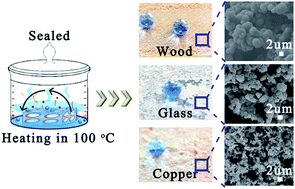A versatile and efficient method to fabricate durable superhydrophobic surfaces on wood, lignocellulosic fiber, glass, and metal substrates†
Abstract
A versatile and highly efficient method was developed to fabricate durable, superhydrophobic surfaces on various substrates, including wood, lignocellulosic fibers, cotton textiles, glass, and metals. This method employs various nanoparticles (i.e., SiO2 and TiO2) in combination with vinyltriethoxysilane (VTES) modification under gravity and pressure. The obtained superhydrophobic surfaces exhibited water contact angles greater than 150° and water sliding angles less than 4.5°. The superhydrophobicity of the coated surfaces was created by the random distribution of oligomer-wrapped nanoparticles having different sizes and shapes, and the oligomer originated from the hydrolyzed VTES. All superhydrophobic surfaces were able to sustain different types of abrasion, including finger wiping, brushing, and knife scratching. The mechanical durability of these superhydrophobic surfaces, with the exception of cloth and textiles, maintained the original superhydrophobicity even after intense sandpaper-induced abrasion. The excellent tolerance against vigorous abrasions was attributed to the hierarchical structure and strong interfacial adhesion of the coatings. Furthermore, all surfaces survived under the environmental conditions of 35 °C and 90% RH for 96 h. It was confirmed that these surfaces exhibited excellent self-cleaning and oil/water separation properties. The modification method developed in this work provides a facile, efficient route to fabricate large-scale, mechanically stable, and durable superhydrophobic surfaces for a wide range of potential applications.

- This article is part of the themed collection: 2016 Journal of Materials Chemistry A HOT Papers

 Please wait while we load your content...
Please wait while we load your content...